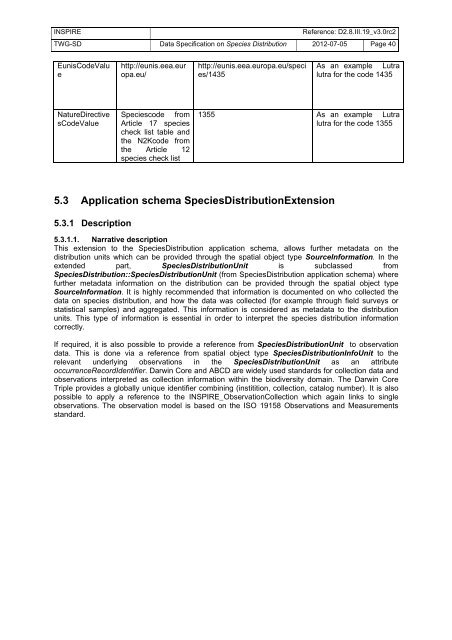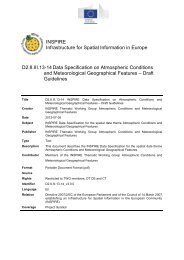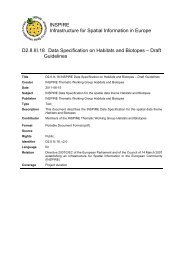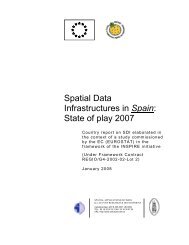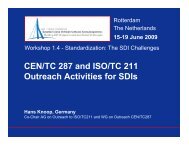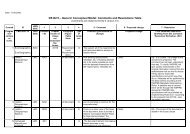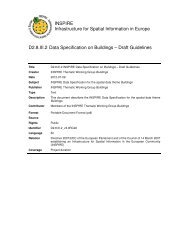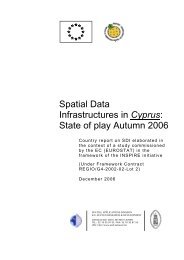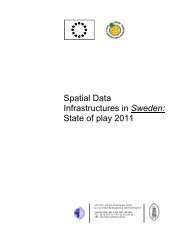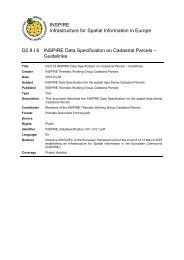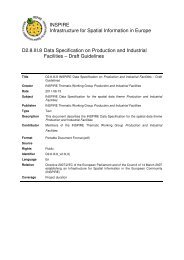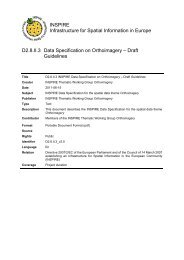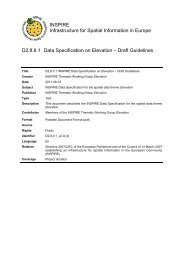Download Version 3.0 rc2 - Inspire - Europa
Download Version 3.0 rc2 - Inspire - Europa
Download Version 3.0 rc2 - Inspire - Europa
Create successful ePaper yourself
Turn your PDF publications into a flip-book with our unique Google optimized e-Paper software.
INSPIRE Reference: D2.8.III.19_v<strong>3.0</strong><strong>rc2</strong><br />
TWG-SD Data Specification on Species Distribution 2012-07-05 Page 40<br />
EunisCodeValu<br />
e<br />
NatureDirective<br />
sCodeValue<br />
http://eunis.eea.eur<br />
opa.eu/<br />
Speciescode from<br />
Article 17 species<br />
check list table and<br />
the N2Kcode from<br />
the Article 12<br />
species check list<br />
http://eunis.eea.europa.eu/speci<br />
es/1435<br />
As an example Lutra<br />
lutra for the code 1435<br />
1355 As an example Lutra<br />
lutra for the code 1355<br />
5.3 Application schema SpeciesDistributionExtension<br />
5.3.1 Description<br />
5.3.1.1. Narrative description<br />
This extension to the SpeciesDistribution application schema, allows further metadata on the<br />
distribution units which can be provided through the spatial object type SourceInformation. In the<br />
extended part, SpeciesDistributionUnit is subclassed from<br />
SpeciesDistribution::SpeciesDistributionUnit (from SpeciesDistribution application schema) where<br />
further metadata information on the distribution can be provided through the spatial object type<br />
SourceInformation. It is highly recommended that information is documented on who collected the<br />
data on species distribution, and how the data was collected (for example through field surveys or<br />
statistical samples) and aggregated. This information is considered as metadata to the distribution<br />
units. This type of information is essential in order to interpret the species distribution information<br />
correctly.<br />
If required, it is also possible to provide a reference from SpeciesDistributionUnit to observation<br />
data. This is done via a reference from spatial object type SpeciesDistributionInfoUnit to the<br />
relevant underlying observations in the SpeciesDistributionUnit as an attribute<br />
occurrenceRecordIdentifier. Darwin Core and ABCD are widely used standards for collection data and<br />
observations interpreted as collection information within the biodiversity domain. The Darwin Core<br />
Triple provides a globally unique identifier combining (institition, collection, catalog number). It is also<br />
possible to apply a reference to the INSPIRE_ObservationCollection which again links to single<br />
observations. The observation model is based on the ISO 19158 Observations and Measurements<br />
standard.


